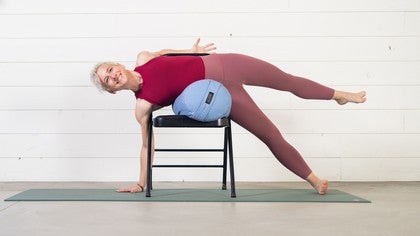
Restorative Yoga for Chronic Pain
Chronic pain is different for everyone. It can disrupt sleep, sap energy, complicate personal and work relationships, and interfere with even the simplest tasks.
“Chronic pain is multi-dimensional,” writes Nandini Vallath in the Indian Journal of Palliative Care. The experience of chronic pain, in other words, isn’t just in the body. It can radiate through all aspects of a person’s life. For some, yoga offers relief as part of a pain management strategy because it addresses the physical and emotional dimensions of chronic pain.
What is chronic pain?
When you stub your toe, pain signals fire immediately and for a finite duration. This is called acute pain. But with chronic pain, pain signals are continuous and can last for years.
With all those pain signals, the nervous system enters a state of hyperarousal. Muscles bear continual tension. Breath is shallow. Sleep, energy, and appetite can all suffer.
The dominoes fall. There is a correlation, for example, between chronic pain and anxiety and depression; people with chronic pain may also experience social isolation and loneliness, all of which can result in a poor overall quality of life.
This experience can be distressing and stressful. Stress can be a trigger for chronic pain disorders, and chronic pain disorders cause stress. The pain cycle perpetuates.
Why yoga for chronic pain?
Yoga's healing combination of meditation, pranayama, and asana are what can allow it to be an effective treatment for the complex nature of pain.
Chronic pain conditions such as arthritis, fibromyalgia, migraine, and low back pain can all be helped with yoga. Studies have shown yoga to be more effective than standard medical care in some cases of chronic back pain. Multiple studies have shown yoga can reduce muscle stiffness and joint pain, strengthen the body, and improve range of motion and flexibility.
"Practicing yoga has the opposite effect on the brain as does chronic pain," says M. Catherine Bushnell, PhD, of the Pain and Integrative Neuroscience Branch of the National Center for Complementary and Integrative Health.
On the physiological level, yoga trips the body’s “relaxation response”—kind of like your system’s off switch. Blood pressure and heart rate regulate. Breathing slows. We move out of “fight or flight” and into “tend and befriend.” Over time, this consistent mind-body practice affects the actual structure of the brain and the way we perceive pain.
A consistent restorative yoga practice, with its focus on relaxation, surrender, and breathing interrupts the pain cycle and alters our perception of that pain. Yoga doesn’t just help you feel less bad; studies show it actively enhances feelings of wellbeing.
But you don’t need a study to tell you what you already know first-hand—that yoga can induce deep physical and emotional feelings of wholeness. Yoga may not “fix” everything in life, but it can make everything feel better.
What to try
Pranayama
Simple breath awareness can help regulate the nervous system, helping to usher in feelings of calm that balance the mental, physical, and subtle bodies.
Try this alternate nostril breathing practice with Richard Rosen:
In a comfortable seated position, place your left hand on your left knee. Raise the right hand to your forehead and place your index finger and middle finger on your third eye. Close the right nostril with your thumb. Inhale through your left nostril. Close the left nostril with your ring finger, and exhale through your right nostril. Breathe in through the right nostril, then close the right nostril with your thumb. Breathe out through the left nostril. This is one cycle. Complete for up to five minutes.
Upavistha Konasana (Wide-Legged Seated Forward Bend)
Set up a chair in front of you, place a blanket, towel, or pillow on the seat, and sit wide-legged on the floor facing the chair. Bend the knees slightly or place a blanket or cushion under your seat to help with tightness in the hamstrings. Hinge forward at the hips and rest your forehead on the blanket or on your hands. Take a longer deeper inhale, then exhale fully, return to normal breathing, and repeat as you feel for it.
Follow along with Yoga Anytime teacher Leeann Carey as she leads us in this calming pose.
Savasana (Corpse Pose)
This pose, usually practiced at the end of class, can take center stage in a restorative yoga practice for chronic pain. Knees elevated on a rolled up blanket can help address pain in the lower back.
Comments
No comments yet. Be the first!










You need to be a subscriber to post a comment.
Please Log In or Create an Account to start your free trial.